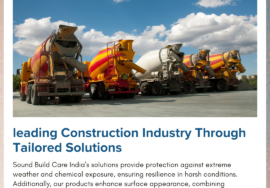Facility Stair Safety: More Effectively Preventing Slips and Falls on High Traffic Stairs
[ad_1]
In commercial facilities across the country, the most common technique for preventing slip and fall accidents on stairs is the application of non-skid adhesive tapes or epoxy coatings embedded with aggregate. The appeal of this approach is that untrained personnel can quickly and easily apply the protection.
However, for high traffic stairways, tapes can peel off (creating a trip hazard) and coatings abrade away quickly, leading to frequent reapplication every few months to maintain safety standards.
Now, a new category of durable high-tech epoxy is available as solution to effectively ensure superior stair tread footing, safety and visibility for years without re-application. This option dramatically reduces the need for maintenance and replacement even in heavily traveled areas and can be quickly and easily applied on stair treads by facility personnel.
 Untrained personnel can quickly and easily apply the Form-A-Tread protection.
Untrained personnel can quickly and easily apply the Form-A-Tread protection.
The Slip and Fall Epidemic
Slip and fall incidents are a leading cause of injury and a factor in many workers’ compensation claims.
“In general, falls and slips are responsible for 15% of all accidental deaths, the second leading cause behind motor vehicles and account for 25% of all reported injury claims,” according to The National Institute for Occupational Safety and Health (NIOSH). “Injuries from falls of all types cause a variety of strains, sprains, fractures, contusions, concussions, back injuries, paralysis, as well as fatalities, particularly when the fall is from a height.”
The risk of a serious fall on stairs inevitably increases when people are inattentive, looking at their smartphones, talking with others or carrying items. The slip and fall hazard – both in terms of physical injury and potential liability – only increases when the stairs are wet and slippery, or the area is not well illuminated.
To dramatically improve facility safety, enhancing the traction, feel and visibility of stair treads is the most effective means of reducing slip and fall incidents and injuries.
A Long-Term Safety Solution
Enhancing the traction of stair treads to improve safety is not a new concept. However, most options on the market are decidedly low-tech, such as applying non-skid adhesive tape or a coating with embedded aggregate to each tread.
“We have nice tile stairs throughout the property, and we could not find anything that would [adequately] stick to the porcelain says Harry Ramos, Head of Facilities at Bear Lakes Country Club in West Palm Beach.
He notes that spiked golf shoes, rain and hot, humid weather dramatically shortened the paint’s lifespan due to peeling and chipping.
According to Ramos, when a representative for a high-traffic paint suggested that a primer should be applied before the coating, it still proved unsatisfactory.
“Golfers’ spiked shoes chipped the paint and after only a week it started to look worn,” he says.
Another common solution at many facilities is the application of a non-skid tape embedded with aggregate. However, if the adhesive does not adhere well to the surface, it can peel off and become a trip hazard within a few months.
The aggregate in the tape is only lightly embedded on the surface as well, and in high traffic areas can quickly wear away. In addition to reducing safety, poorly maintained stairs with worn coatings or peeling tape portray a shoddy, unprofessional image as well.
“We have many highly used stairs and were re-applying the paint or non-skid tape about once a month,” Ramos says. “After a while, we felt it was a waste of time.”
Fortunately, Ramos discovered a more durable epoxy paste consisting of 100% solids that, once applied, can last for years in high traffic areas. The patented product from Form-A-Tread Company provides an extremely strong bond to a range of stair tread surfaces, with embedded aggregate to increase traction.
The epoxy paste can be used indoors or outdoors as well as exposed to chemicals, weather and temperature extremes. The bond is so strong that a chisel or angle grinder is required to remove the stair tread line, an advantage in high traffic areas.
 Form-A-Thread products dramatically reduce the need for maintenance and replacement even in heavily traveled areas.
Form-A-Thread products dramatically reduce the need for maintenance and replacement even in heavily traveled areas.
In the case of Bear Lakes Country Club, Ramos applied the Form-A-Tread epoxy paste to improve safety and minimize the possibility of members slipping on stairs given the hot, humid, and wet weather in Florida. “The epoxy sticks to just about anything – including the porcelain tile – and really lasts. A year after we applied the epoxy to our stairs the original [tread] traction is still there, and I do not see any wear and tear. It looks like it was applied last week,” says Ramos.
In addition to the high traffic from members, the stairs also are power washed every three months without affecting the epoxy.
Ramos also appreciates how quickly the epoxy cures, which reduces the length of time that facility stairs are unavailable for use.
“The epoxy dried enough that it could be walked on in only a few hours, even here in Florida. That meant we didn’t need to shut down the stairs for too long,” he says.
The high strength epoxy paste is designed to be easy to apply to stair treads by even untrained personnel. In a kit supplied by Form-A-Tread, there is a 400 ml cartridge of material that can produce 25 to 40 linear feet of one-inch-wide tread depending on the surface type.
A special tool is then used to dispense and mix the material at the time of application in the correct ratio – eliminating the risk of human error.
The kit includes a patent pending stencil system, so the one-inch-wide tread lines remain clean, neat and parallel. In addition to straight line treads, instructions such as “Exit Here” or a corporate logo can be applied using the material and a stencil.“
The kit is easy to use and supplies everything you need. I applied the product the first time and then trained two members of my work crew how to do it within five minutes,” says Ramos.
For added safety, the 100% epoxy tread line does not shrink and so provides a superior tactile sensation that creates greater awareness of footing when climbing or descending stairs.
The product is available in black and safety yellow to delineate the edge of each stair tread. To increase safety in low light, indoor facility settings, the company also offers a patented photoluminescent version of the stair tread safety product which glows-in-the-dark to provide greater visibility.
According to Ramos, the epoxy product not only improved safety and eliminated the need for constant re-application, but also had a more aesthetic look over time due to the lack of visible wear. He points out that this is important since paying members expect the facility to be safe, attractive and well maintained.“
So far, it has been one year since the epoxy was applied and it looks like we applied it last week,” says Ramos. “I expect it to last in good condition for another 5-10 years.”
Facility managers like Ramos have long sought to improve the safety of stairs. However, the traditional methods of adding traction and visibility to stair treads are short-lived and high maintenance.
With advanced durable all-solid epoxy pastes that adhere to stair treads for many years, facility managers now have an easy-to-use tool that can improve safety for the long-term.
—
Del Williams is a technical writer based in Torrance, California.
[ad_2]
Source link










